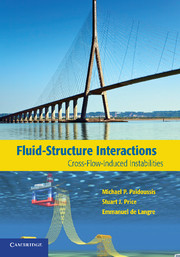Book contents
- Frontmatter
- Contents
- Preface
- 1 Introduction
- 2 Prisms in Cross-Flow – Galloping
- 3 Vortex-Induced Vibrations
- 4 Wake-Induced Instabilities of Pairs and Small Groups of Cylinders
- 5 Fluidelastic Instabilities in Cylinder Arrays
- 6 Ovalling Instabilities of Shells in Cross-Flow
- 7 Rain-and-Wind-Induced Vibrations
- Epilogue
- Appendix A The Multiple Scales Method
- Appendix B Measurement of Modal Damping for the Shells Used in Ovalling Experiments
- References
- Index
5 - Fluidelastic Instabilities in Cylinder Arrays
Published online by Cambridge University Press: 04 February 2011
- Frontmatter
- Contents
- Preface
- 1 Introduction
- 2 Prisms in Cross-Flow – Galloping
- 3 Vortex-Induced Vibrations
- 4 Wake-Induced Instabilities of Pairs and Small Groups of Cylinders
- 5 Fluidelastic Instabilities in Cylinder Arrays
- 6 Ovalling Instabilities of Shells in Cross-Flow
- 7 Rain-and-Wind-Induced Vibrations
- Epilogue
- Appendix A The Multiple Scales Method
- Appendix B Measurement of Modal Damping for the Shells Used in Ovalling Experiments
- References
- Index
Summary
Description, Background, Repercussions
A cylinder array is an agglomeration of cylinders parallel to one another in a geometrically repeated pattern. Typical examples are tube arrays in heat exchangers, involving hundreds or thousands of tubes; one fluid flows within the tubes, while another flows around them, partly normal to their long axis (cross-flow). Here, by heat exchangers we understand also steam generators and boilers, where the outer fluid boils and produces steam, and condensers, where the reverse process is involved. Figure 5.1 shows sectional views of two different types of steam generators. In both cases, the outer fluid flows axially in some regions and transversely as a cross-flow in others (Païdoussis 1981, 1983, 2004). It is well known that cross-flow promotes heat transfer, but at the expense of higher vibration levels and the possibility of cross-flow-induced instabilities, the subject matter of this chapter. Figure 5.2 shows the winding pattern of the outer flow in another kind of heat exchanger, involving cross-flow nearly everywhere.
What distinguishes heat-exchanger arrays compared with the groups of cylinders discussed in Chapter 4 is that (i) we have many more cylinders here and (ii) they are more closely spaced. The significance of (i) is that, other than the cylinders crosssectionally on the periphery, the flow around any given cylinder is confined by the presence of adjacent cylinders, rather than being unconfined at least on one side.
- Type
- Chapter
- Information
- Fluid-Structure InteractionsCross-Flow-Induced Instabilities, pp. 215 - 290Publisher: Cambridge University PressPrint publication year: 2010



